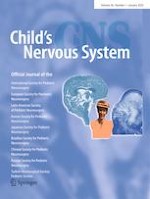Erschienen in:

04.07.2019 | Focus Session
Transcranial Doppler as a non-invasive method to estimate cerebral perfusion pressure in children with severe traumatic brain injury
verfasst von:
Francisco Abecasis, Danilo Cardim, Marek Czosnyka, Chiara Robba, Shruti Agrawal
Erschienen in:
Child's Nervous System
|
Ausgabe 1/2020
Einloggen, um Zugang zu erhalten
Abstract
Introduction
Cerebral perfusion pressure (CPP) is one of the most important parameters in preventing ischemic brain insults. Guidelines have used CPP values to guide treatment of traumatic brain injury (TBI) for many years. We tested the feasibility of a novel non-invasive method for CPP estimation (nCPP) in children with severe TBI.
Methods
Retrospective analysis of prospectively monitored pediatric TBI patients with invasive intracranial pressure (ICP) monitoring, arterial blood pressure, and Transcranial Doppler (TCD) studies was performed daily. A novel estimator of CPP (nCPP) was calculated using TCD-spectral accounting method. We analyzed the correlation coefficient and correlation in time domain between CPP and nCPP, prediction ability of nCPP to detect low CPP, and the confidence intervals for CPP prediction (95% CI).
Results
We retrospectively analyzed 69 TCD recordings from 19 children (median age 15 years, range 3–16 years). There was a good correlation between CPP and nCPP (Spearman correlation coefficient, R = 0.67 (p < 0.0001), and a good mean correlation in time domain (R = 0.55 ± 0.42). The ability of nCPP to predict values of CPP below 70 mmHg was excellent as demonstrated by an area under the curve of 0.908 (95% CI = 0.83–0.98) using a receiver operating curve analysis. Bland-Altman analysis revealed that nCPP overestimated CPP by 19.61 mmHg with a wide 95% CI of ± 40.4 mmHg.
Conclusions
nCPP monitoring with TCD appears to be a feasible method for CPP assessment in pediatric TBI. The novel spectral CPP tested in this study has a decent correlation with invasive CPP and can predict low CPP with excellent accuracy at the 70-mmHg threshold.